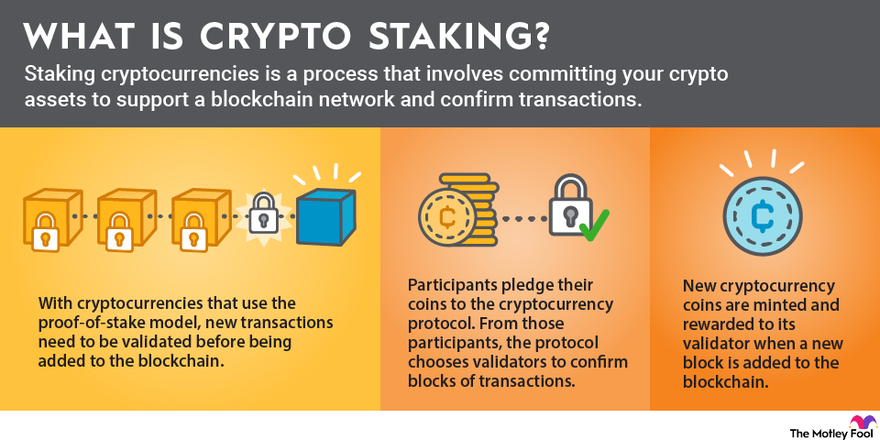
Crypto staking is quickly becoming a popular way for investors to make passive income. By simply holding on to their cryptocurrencies, users can participate in the verification process of various blockchain networks and earn rewards at the same time! It is important to note that not all cryptocurrencies can be staked, with the most notable being Bitcoin. In this article, we will explain what crypto staking entails, as well as its related risks and factors you should consider before participating.
Short Summary
- Crypto staking is a way to earn passive income by locking up digital assets and validating transactions.
- Before deciding to stake crypto, consider potential returns, risks, your level of technical expertise & market volatility.
- Secure wallets & platforms are essential for minimising security concerns when staking crypto.
Contents
- The Basics of Crypto Staking
- Popular Cryptocurrencies Supporting Staking
- Evaluating Staking Returns
- Risks Associated with Crypto Staking
- Summary
- Frequently Asked Questions
The Basics of Crypto Staking

Crypto staking involves using digital assets to back a blockchain network. It is primarily used in Proof of Stake (PoS) cryptocurrencies, where participants can earn rewards for taking part in the validation process. It is similar to having a term deposit that pays interest for locking up your crypto. Depending on the cryptocurrency and its underlying blockchain, different reward amounts will be generated.
Keep in mind that risks like market volatility and lock-up periods may have significant negative impacts when participating in crypto staking. So be sure to do as much research as possible before you stake.
Proof of Stake (PoS) Consensus Mechanism
Proof of Stake (PoS) is a consensus system that chooses validators based on the number and type of coins they hold. Instead of needing to solve complex equations via Proof-of-Work (PoW) like for the Bitcoin network, PoS users can secure the network by “staking” funds, allowing them to validate transactions for rewards, usually in the form of the coin native to the network.
The way blocks are processed differs between PoS and Pow. With proof-of-stake, rather than mining, it’s known as “forging.” The selection process works so that those who offer up larger amounts of tokens gain greater chances at becoming the validator. In return they receive transaction fees and blockchain rewards.
Centralisation is a concern if only several groups or individuals run validators on the network. This gives them too much control over operation factors related to the network. This is more commonly seen with newer blockchains that are yet to have more people create nodes and become validators. Over time, if a blockchain sees more user adoption, centralisation risk decreases.
Role of Validators
Validators are key to the staking process as they take responsibility for authenticating transactions, defending blockchain networks from threats and validating transactions. They may also be penalised if any improper action is taken. For those interested in staking without running their own node, popular crypto exchanges such as Kraken and Coinbase offer staking services through their platforms.
Popular Cryptocurrencies Supporting Staking

Different cryptocurrencies are designed to support staking, and some have made it a feature. These include Ethereum, Cardano, Polkadot, Tezos, Solana, Binance Coin and more. Each coin requires a different amount to be staked to participate in validation. It is often the case that individuals will need to pool together their coins to validate transactions due to the high costs involved. Doing research into each cryptocurrency’s features and having a clear understanding of expected returns is fundamental before engaging in crypto staking.
How to Earn Rewards Through Staking
There are multiple ways to earn staking rewards, from joining pools to using exchange-based services and running validator nodes. It is important to take into account the pros and cons associated with each option in order to make an informed decision that matches your investment goals while minimising risk. Joining pools may result in a lesser total reward, exchange based staking services carry transparency risks on what your tokens are actually being used for, and running a validator node can be expensive.
One should always assess the risk-reward ratio when determining how best to gain passive income through staking activities.
Staking on Exchanges
Some crypto exchanges offer staking services which enable crypto investors to stake their holdings on the platform and gain rewards for a fee. For instance, Binance US and Coinbase have trading-based staking programs that manage all technical operations for an easier user experience.
Staking through an exchange is easy and convenient for those who wish to acquire incentives without needing to operate their own node. It may involve certain risks such as not earning the full returns or being subjected to regulatory implications. Despite these possible drawbacks, utilising an exchange based system can be beneficial in collecting desired awards from stakes.
Participating in Staking Pools
When it comes to staking, crypto holders may band together in a pooling of resources for the purpose of having an increased probability to become validators and obtain their respective rewards. This way individuals can get returns without the need to operate on nodes themselves, and small investors who cannot meet the minimum staking requirements can participate as well.
To join any particular pool, users must inspect its reputation as well as its track record for performance and security so that rewards are not penalised.
Running Your Own Validator Node
More technical users willing to invest time and resources can benefit from increased control and larger rewards when running a validator node. Ethereum for instance requires 32 ETH in order to be eligible for staking. While this option has greater potential rewards, it also carries volatility risks, lockup periods and other tech issues. For advanced users, becoming a validator can provide lucrative passive income.
Evaluating Staking Returns
When it comes to cryptocurrency staking, potential returns and risks need to be carefully weighed. There are a variety of APYs (annual percentage yield) on offer with the highest yielding currencies reaching up to 16% or more. To ensure that you get the best rewards from your chosen currency, take some time researching available options and compare their respective yields.
The reputation and stability of the underlying blockchain network is also something worth looking into before making any decisions about which option might suit you best as this can affect stake-related earnings significantly. Make sure you’re familiarised with all fee, yield, and risk information before staking.
It’s important not only to keep track of changing conditions, but also remember how they influence yield levels at different times. There could well be variations dependent upon both pool size/number participants plus factors linked directly to reward pools themselves.
As such, understanding of the broader crypto market environment is fundamental to informed decision making while maximising profits minimising possible losses. Always be sure to do your own research.
Risks Associated with Crypto Staking
When considering crypto staking, it is imperative to be aware of the potential risks that come with such an investment. Volatility in the market can impact the value of your staked assets and some platforms may have lock-up periods or technical challenges which could restrict access to funds.
It’s important for investors who are interested in crypto staking to evaluate their risk tolerance level as well as any short and long term goals before jumping into this type of investment.
Market Volatility
Investing in staked cryptocurrency can expose you to market volatility, leading to fluctuations in your tokens value. If there is a significant decrease in value, the staking rewards may not cover the total loss of value of the tokens. It’s important that market trends are monitored and assessed when managing these investments. Diversification of investments and having up-to-date knowledge about financial conditions can help mitigate risk brought by fluctuating markets and allow better decisions when considering staking investments.
Lock-up Periods and Accessibility
When staking your assets, it is vital to understand the lock-up periods associated. This period of time might stop you from being able to sell your holdings when you would like to due to your tokens being used for staking.
If quick access and taking advantage of short-term investment possibilities are important factors when considering investing choices, then staking may not be an attractive investment option.
Technical Challenges and Security Concerns
Staking presents potential risks to users such as technical glitches, software malfunctions and security issues. To ensure a more secure experience while staking it is important to use safe wallets, and platforms. It is also important to keep up-to-date with the newest safety updates and practices.
To help minimise risks when looking to stake staking, its important to consider the following:
- Choose only reliable wallets/platforms
- Follow the best current safety practices
- Research thoroughly each staking investment
Summary
Crypto staking offers investors the potential to make passive income while helping secure blockchain networks and being part of validation processes. To be able to take advantage of this opportunity, it’s important to understand how crypto staking works, research popular cryptos that have support staking, and assess different ways of gaining rewards. Always remember there are risks involved including market volatility, lengthy lock-up periods and potential technical issues. Potential investors should do their own research to stay informed about changing trends if they wish maximise their chances of returns through crypto staking.
Frequently Asked Questions
What is crypto staking?
Crypto staking is the process of locking away digital assets in order to support a blockchain network, and be rewarded for participating in its validation. This has become increasingly popular among those looking for ways to earn passive income through their crypto investments. Staking allows you to reap rewards without having to actively trade or manage your assets, and also helps strengthen the security of these networks as well.
How does crypto staking work?
Crypto staking is a process of locking up crypto assets help in the validation of transactions on a blockchain. In return, validators are incentivised through distributed staking rewards as part of their network participation.
Staking permits users to generate an income from existing crypto holdings without having to sell them.
What are the risks of staking crypto?
This type of investment requires taking into account several risks such as market volatility, lock up periods, and technical issues.



